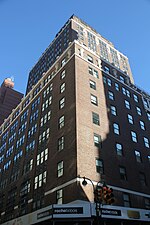Morgan Library & Museum

The Morgan Library & Museum, formerly the Pierpont Morgan Library, is a museum and research library in the Murray Hill neighborhood of Manhattan in New York City. It is situated at 225 Madison Avenue, between 36th Street to the south and 37th Street to the north. The Morgan Library & Museum is composed of several structures. The main building was designed by Charles McKim of the firm of McKim, Mead and White, with an annex designed by Benjamin Wistar Morris. A 19th-century Italianate brownstone house at 231 Madison Avenue, built by Isaac Newton Phelps, is also part of the grounds. The museum and library also contains a glass entrance building designed by Renzo Piano and Beyer Blinder Belle. The main building and its interior is a New York City designated landmark and a National Historic Landmark, while the house at 231 Madison Avenue is a New York City landmark. The site was formerly occupied by residences of the Phelps family, one of which banker J. P. Morgan had purchased in 1880. The Morgan Library was founded in 1906 to house Morgan's private library, which included manuscripts and printed books, as well as his collection of prints and drawings. The main building was constructed between 1902 and 1906 for $1.2 million. The library was made a public institution in 1924 by J. P. Morgan's son John Pierpont Morgan Jr., in accordance with his father's will, and the annex was constructed in 1928. The glass entrance building was added when Morgan Library & Museum was renovated in 2006.
Excerpt from the Wikipedia article Morgan Library & Museum (License: CC BY-SA 3.0, Authors, Images).Morgan Library & Museum
Madison Avenue, New York Manhattan
Geographical coordinates (GPS) Address Nearby Places Show on map
Geographical coordinates (GPS)
| Latitude | Longitude |
|---|---|
| N 40.748888888889 ° | E -73.981944444444 ° |
Address
Madison Avenue 213
10016 New York, Manhattan
New York, United States
Open on Google Maps







